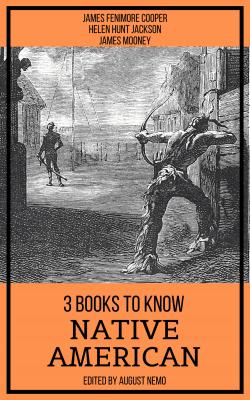3 books to know Native American. Джеймс Фенимор Купер
Читать онлайн.| Название | 3 books to know Native American |
|---|---|
| Автор произведения | Джеймс Фенимор Купер |
| Жанр | Языкознание |
| Серия | 3 books to know |
| Издательство | Языкознание |
| Год выпуска | 0 |
| isbn | 9783967994254 |
Table of Contents
Cosmogonic Myths Of The Cherokee
|
|
|
Introduction
Welcome to the 3 Books To Know series, our idea is to help readers learn about fascinating topics through three essential and relevant books.
These carefully selected works can be fiction, non-fiction, historical documents or even biographies.
We will always select for you three great works to instigate your mind, this time the topic is: Native American.
The Last of the Mohicans by James Fenimore Cooper.
Ramona by Helen Hunt Jackson .
Myths Of The Cherokee By James Mooney.
The Last of the Mohicans: A Narrative of 1757 is a historical novel written by James Fenimore Cooper in 1826. The novel is set primarily in the upper New York wilderness, detailing the transport of the two daughters of Colonel Munro, Alice and Cora, to a safe destination at Fort William Henry. Among the caravan guarding the women are the frontiersman Natty Bumppo, Major Duncan Heyward, and the Indians Chingachgook and Uncas, the latter two being the novel's title characters. These characters are sometimes seen as a microcosm of the budding American society, particularly with regard to their racial composition.
Ramona is an 1884 American novel written by Helen Hunt Jackson. Set in Southern California after the Mexican–American War, it portrays the life of a mixed-race Irish–Native American orphan girl, who suffers racial discrimination and hardship. The novel's influence on the culture and image of Southern California was considerable. Its sentimental portrayal of Mexican colonial life contributed to establishing a unique cultural identity for the region. As its publication coincided with the arrival of railroad lines in the region, countless tourists visited who wanted to see the locations of the novel.
Myths of the Cherokee is a compilation of tales from the oral tradition of the Cherokee people. The work is part of a series of ethnographic studies by James Mooney of the native populations of the USA.
This is one of many books in the series 3 Books To Know. If you liked this book, look for the other titles in the series, we are sure you will like some of the topics.
|
|
|
Authors
James Mooney (February 10, 1861 – December 22, 1921) was an American ethnographer who lived for several years among the Cherokee. He did major studies of Southeastern Indians, as well as those on the Great Plains.
James Fenimore Cooper (September 15, 1789 – September 14, 1851) was an American writer of the first half of the 19th century. His historical romances draw a picture of frontier and American Indian life in the early American days which created a unique form of American literature.
Helen Hunt Jackson (October 15, 1830 – August 12, 1885) was an American poet and writer who became an activist on behalf of improved treatment of Native Americans by the United States government.
|
|
|
The Last of the Mohicans
Chapter 1
––––––––
“Mine ear is open, and my heart prepared:
The worst is worldly loss thou canst unfold:
Say, is my kingdom lost?”
Shakespeare.
––––––––
It was a feature peculiar to the colonial wars of North America, that the toils and dangers of the wilderness were to be encountered before the adverse hosts could meet. A wide and apparently an impervious boundary of forests severed the possessions of the hostile provinces of France and England. The hardy colonist, and the trained European who fought at his side, frequently expended months in struggling against the rapids of the streams, or in effecting the rugged passes of the mountains, in quest of an opportunity to exhibit their courage in a more martial conflict. But, emulating the patience and self-denial of the practised native warriors, they learned to overcome every difficulty; and it would seem that, in time, there was no recess of the woods so dark, nor any secret place so lovely, that it might claim exemption from the inroads of those who had pledged their blood to satiate their vengeance, or to uphold the cold and selfish policy of the distant monarchs of Europe.
Perhaps no district throughout the wide extent of the intermediate frontiers can furnish a livelier picture of the cruelty and fierceness of the savage warfare of those periods than the country which lies between the head waters of the Hudson and the adjacent lakes.
The facilities which nature had there offered to the march of the combatants
